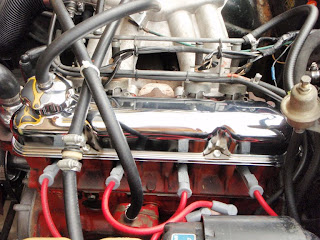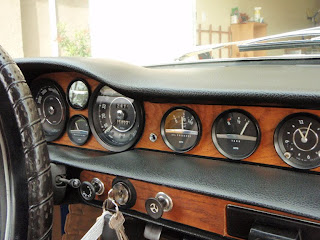I got the Volvo back from the shop earlier this week and it's purring like a kitten! Erratic idle - gone! Engine Stalling - gone! Running rich - not anymore! I took it to a shop in town called British Steel Restorations. Rick Rogers, the proprietor, and a former helicopter mechanic specializes in the restoration of classic British automobiles. I figured, if he can fix helicopters, he'll surely be able to fix the Volvo! I've known Rick for a couple of months prior to taking the Volvo in for work ... having sought him out, and set up a couple of meet-and-greets to tour his facility, evaluate his work, and more importantly, to lure him to the dark side by coercing him to temporarily abondon his staple of fine British classics to work on my Volvo as it surely has enough British components in it to qualify. It does - Smith gauges, Lucas electrical components, Laycock De Normanville overdrive is similar to the TR6 or 7 models, etc.
Are there any other places in town to take the Volvo to? Sure, but I'm extremely particular when it comes to people working on my car as I don't want it to be molested by any regular mechanic with a socket wrench. It has to be someone who is also a collector, who specializes in vintage vehicles, who will handle my Volvo like they would a radioactive fuel rod. Hence, the many months of research and interviews for just the "right" mechanic. There are Volvo dealerships that I could have taken it to, but I doubt that they still employ the guys that were around when the 1800s were still on the market. Plus, they usually don't let you "hang-out" and watch while they work on your car - where's the fun in that? Anyone who no speaka ingrish - is automatically disqualified. Shops that won't allow me to bring in my own parts were also disqualified (it's a sign that they'll mark-up the parts that they'll undoubtedly need to source from a third-party). Mechanics with a low teeth-to-tattoo ratio were also disqualified (different though if you need radiator work done - you'd want the biker guys with the low teeth-to-tattoo ratio, as they really know their shit!).
The main reason for the visit was to have the Volvo complete its tune-up with an oil change, valve adjustment, oil filter replacement, and have Rick verify with his instuments all my prior adjustments to the idle richness, timing, idle & throttle settings. The stuff that I messed with were all pretty close, but we (by "we", I mean "Rick") did it again with instruments this time to get them within factory specs. Turns out, all the valves needed adjusting - which is most likely the cause of the erratic idling and engine stalling. With everything dialed in to specs, the engine is running much quieter and better than its ever been since I've had the car!
Arrival at British Steel Restorations:

| Chromed Valve Cover & Oil Cap:

|
Pictured above, on the right, is the chromed valve cover & oil filler cap that I stole off eBay about 8 months ago. I've been itching to get it on the engine ever since, and now the opportunity has presented itself with the removal of the old valve cover for the valve adjustments. Pictured below are the before-and-after photos of the engine bay with the old vs. chromed valve cover in place. Take a closer look at the chromed valve cover and you'll see the valve cover hold-down kit that I got from IPD. These valve covers are prone to distortion from overtightening the mounting screws. This leads to improper sealing and oil leaks. The hold-down kit spreads the clamping force over a larger area, allowing the gasket to better seal against the cylinder head.
Before:

| After:

|
Another thing that I had done while the car was in the shop was the replacement of the rubber steering coupler. Mine had a few tears in it. It is a part that is often overlooked when purchasing a vintage vehicle, but is crucial as you will lose the ability to steer if it comes off! I also instructed Rick to take a good look at the entire vehicle to identify anything that might affect drivability or safety that needed replacing. He found one - the driver-side tie rod was "barely" hanging on and it was promptly replaced with a brand new one from IPD. Other than that, Rick's report was very encouraging - everything under the car looked solid, no rust on the floor pans or cross members. The car is mechanically and structurally sound. The rest is just appearance items or aged parts that currently do not affect the drivability or safety of the vehicle and can be swapped out at my leisure.
I also had Rick perform a compression check on the engine just for the heck of it, and the results for each of the 4 cylinders were well within the range for an engine of its age, and the variances across cylinders were within norm (I don't have the test result on hand right now, and it's all greek to me anyway - all I know is he says it's all good, so I'm driving it across the Atlantic). At one point Rick even had a scope down the fuel tank and was happy to report that it looked like it was in great shape and the outbound fuel was clean. Good news for me, as it's one less thing to restore!
Before:

| After:

|
ZDDP - I read somewhere that it's good for flat tappet engines (here and here, I think!). Unfortunately modern engine oils no longer have it, but here's an additive that I bought from iRollMotors.com called ZDDPlus (picture below, left) that can be added to the engine at each oil change. I also found out later that Valvoline VR1 20W-50 motor oil still has the appropriate levels of the stuff, so that'll be the oil I'll be using in the future with no need to spend the extra $10 for the ZDDPlus additive.
ZDDP Additive:

| Instrument Cluster:

|
Ever since I've had the Volvo, the following instruments on the dash were not working: Oil temperature gauge, fuel gauge, turn signal indicators on the dash would only flash once, and the emergency brake warning light on the dash would stay lit all the time the car was running. The gauges were in working condition, just the wiring (or in the case of the oil temperature gauge, the sensor) needed some attention. Well ... the oil temperature gauge was a simple fix. Installing a new oil temperature sender during the oil change solved that problem. As for everything else ... heck of a lot easier as it turns out! The brake warning light first of all has a dual purpose - It lights up when the the emergency brake is engaged when the engine is running, and it lights up when there is unequal pressure in the brakes as sensed by a switch in the engine bay. Neither of which applies in my case as I'm aware that the previous owner had some electrical work done by his mechanic which resulted in 2 things happening - the warning light being lit all the time, and the fuel gauge stopped working. This is where the giant colored wiring diagram I purchased a couple weeks ago proved useful. It seems that the previous mechanic got creative with one particular wire in the dash, and upon removing the "stray wire", everything on the dash started working! I mean everything ... the fuel gauge works perfectly now and it is accurate (we tested). The brake warning light works like it should. Even the turn signal indicators on the dash started behaving - they flash continuously until disengaged. Bonus! I'm crossing off a bunch of stuff from my to-do list with one pull of a wire!


2 comments:
Jason,
glad to hear the 1800 is purring again. So have you determined that the valve adjustment was the cause of the rich running?
E
Thanks! No - the rich running was caused by the idle enrichment knob on the ECU being set too high. This knob affects only idle richness. Clockwise = richer, counter-clockwise = leaner. It's also a combination of adjusting the idle mixture via this knob and adjusting the idle via the idle adjustment screw on the intake manifold to arrive at a "happy" air-fuel ratio at idle.
The valves, I suspect is likely the cause of the car stalling after running for a while. After we adjusted the valves, the stalling stopped.
Post a Comment